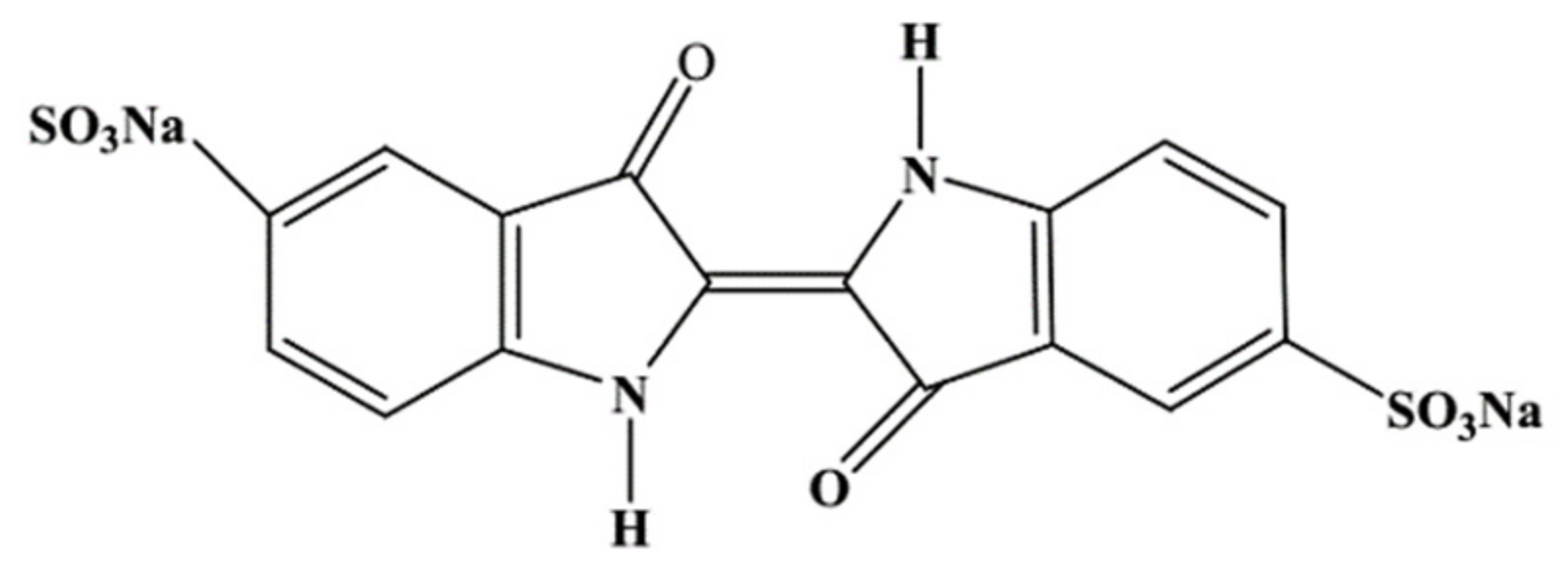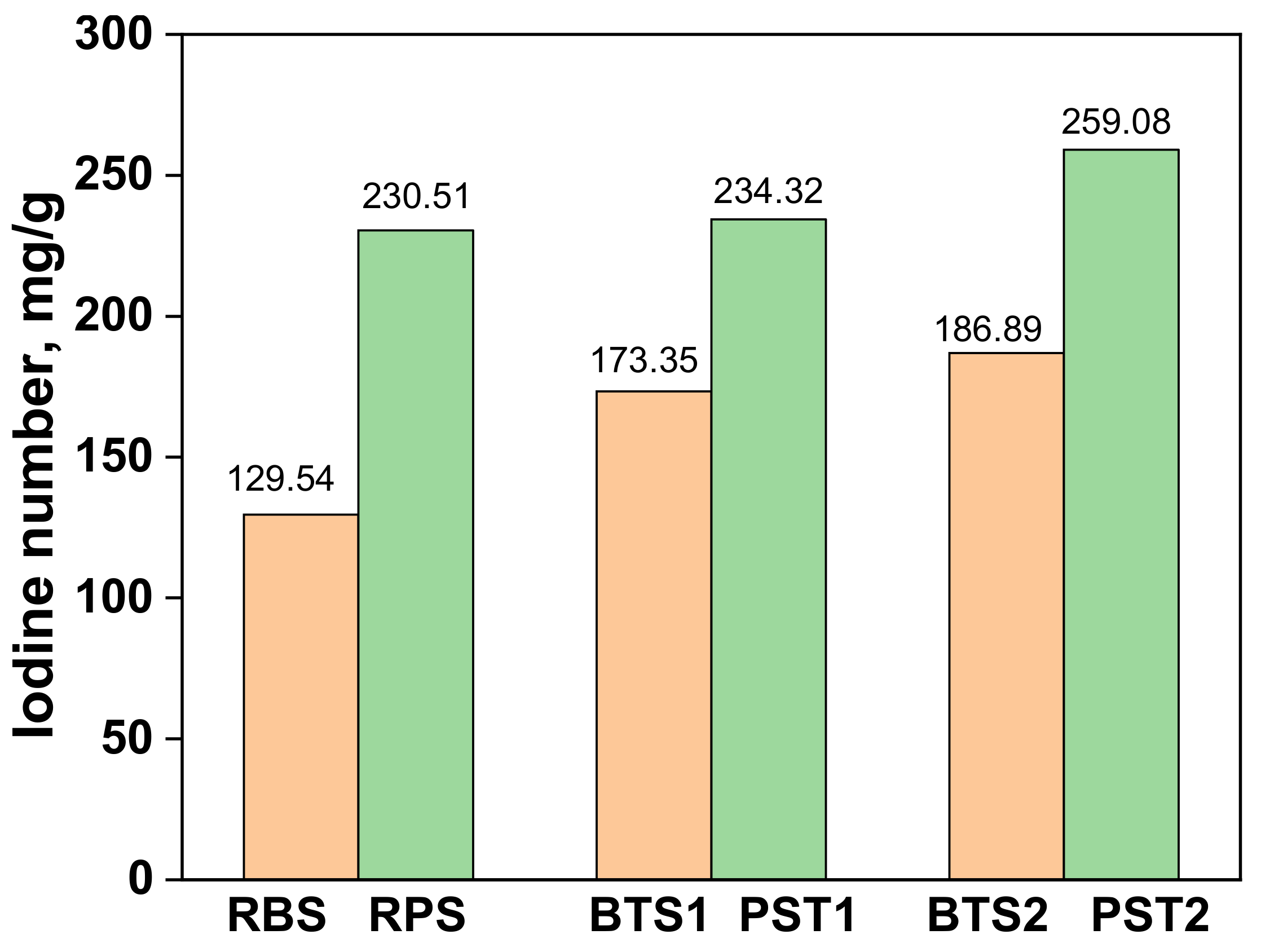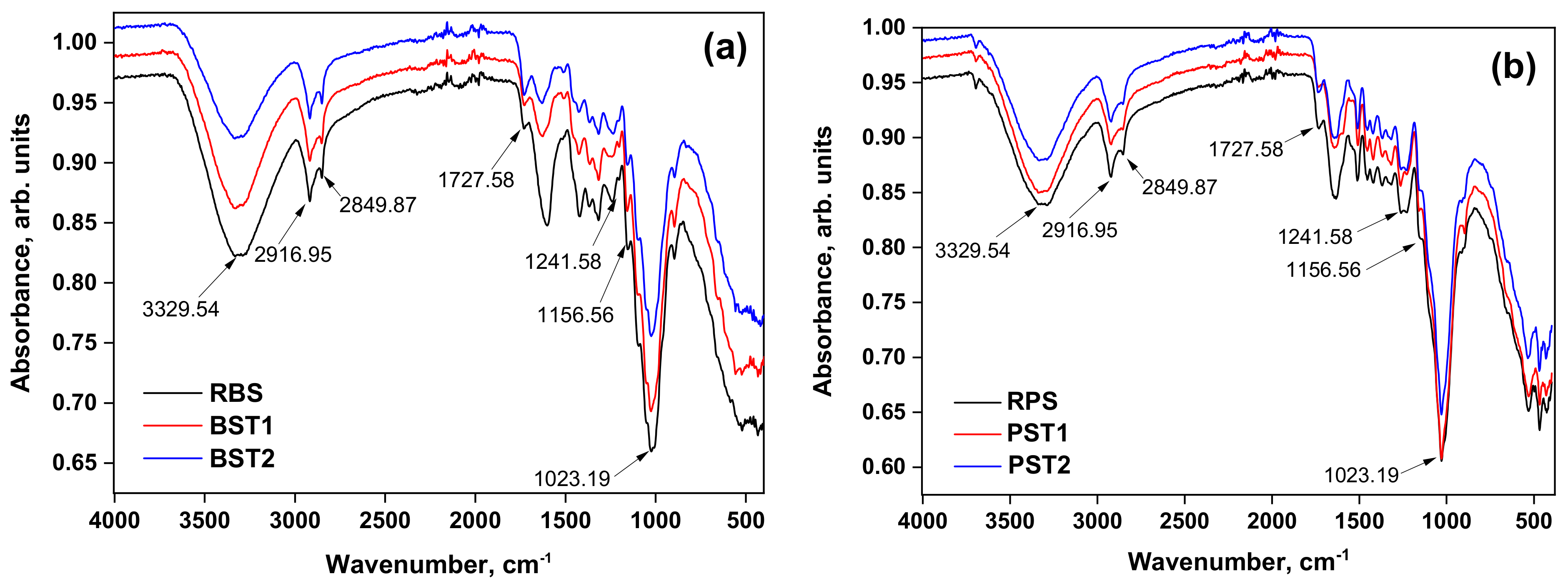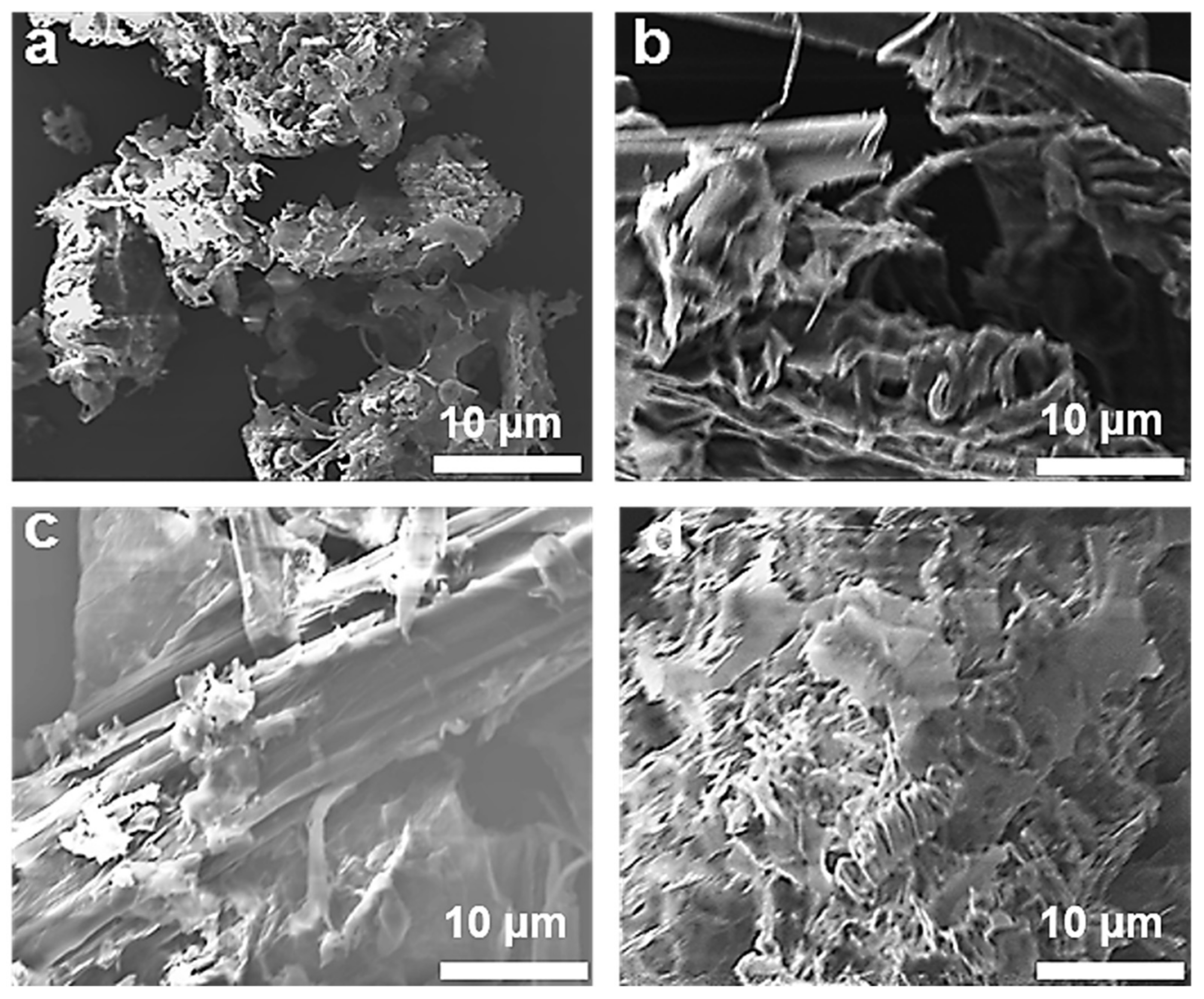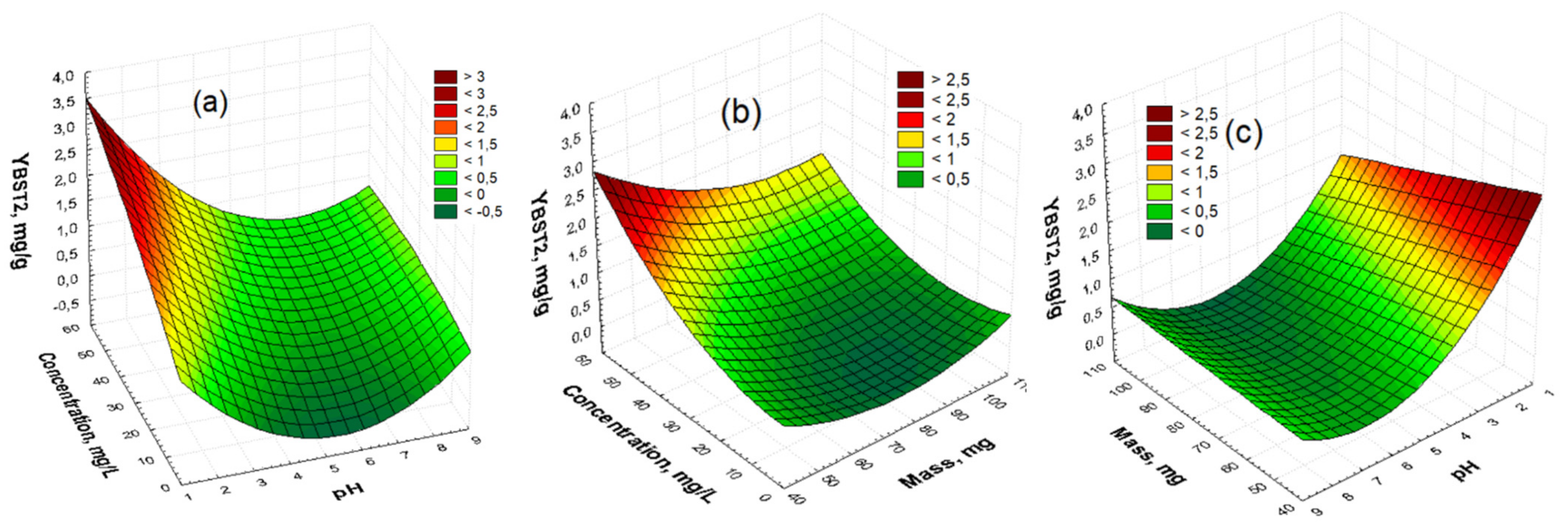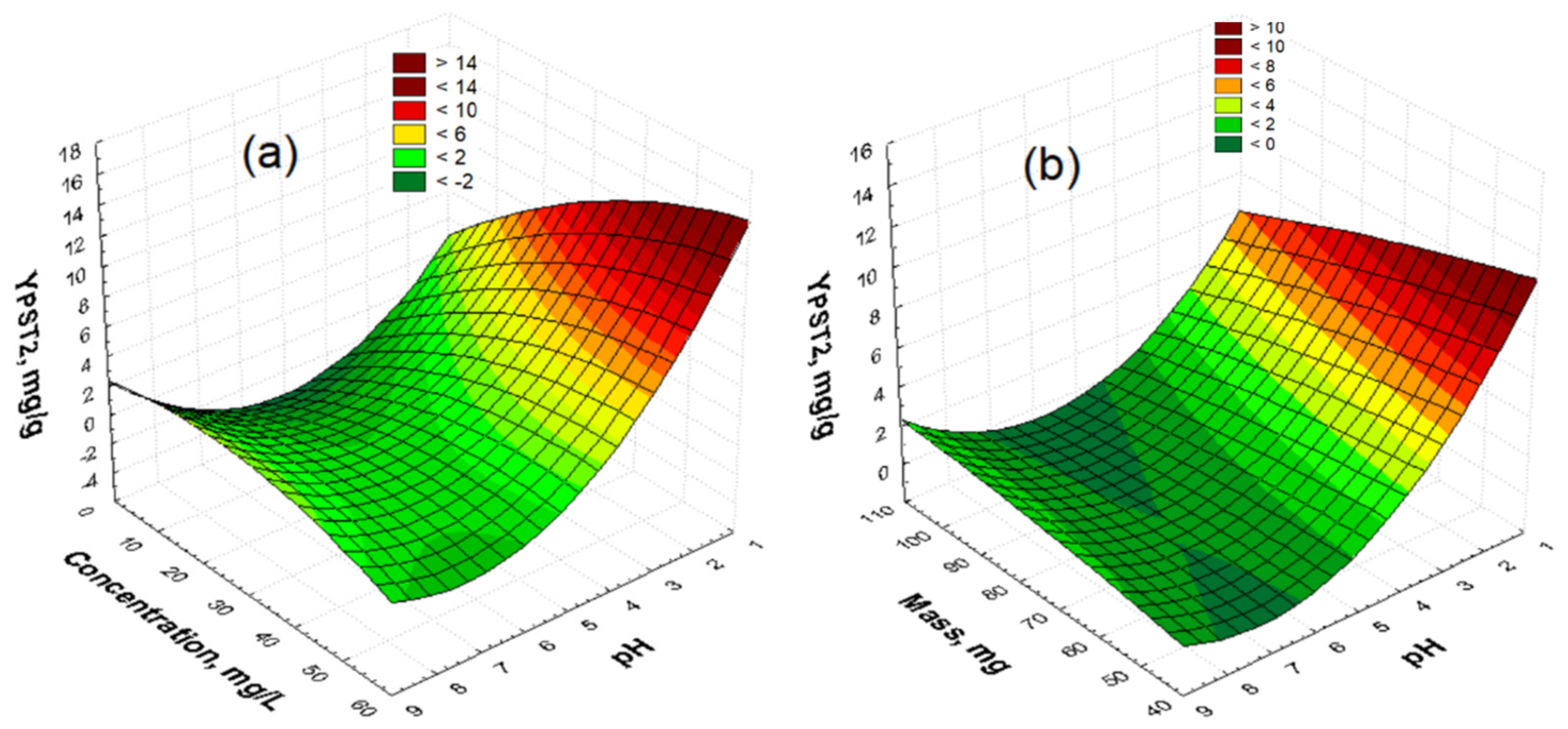3.1. Adsorbent Material Characterization
Figure 1 shows the iodine numbers of raw and treated materials. It is worth noticing the increasing variation in the iodine numbers in the raw materials with respect to the treated materials: with bean pod samples, 129.54 mg.g
−1 for RBS to 173.35 mg.g
−1 for BST1 and to 186 69 mg.g
−1 for BST2. With regard to pistachio pods, values were 230.51 mg.g
−1 for RPS, to 234.32 mg.g
−1 for PST1 and to 259.08 mg.g
−1 for PST2. This phenomenon should be due to the increased particle size, which leads to an increase in the number of active sites of the pores available at the surfaces of the modified materials.
The pH at zero point of charge pH
pzc is a good indicator of the chemical and electronic properties of functional groups. Thus, when pH
pzc > pH, the surface of the material is positively charged, while when pH
pzc < pH, the surface is negatively charged [
63]. One can observe in
Figure S1 (Supplementary Materials) a decrease in the pH
pzc from the raw material to the treated material: with bean pod samples, RBS (4.73), BST1 (3.21), and BST2 (2.38); with pistachio pod samples, RPS (4.90), PST1(4.43), and PST2 (2.40). This decrease in pH
pzc values can be explained by the fact that the different treatments involve the reduction of basic functions and an increase in acidic functions.
Figure 2 presents the XRD patterns of bean and pistachio pods samples. An amorphous structure and low crystallinity were observed for all studied materials. These patterns also displayed diffraction peaks at 2θ = 14.9°, 16.5°, 21.7°, and 34.7° corresponding to the (1–10), (110), (200), and (004) crystallographic planes of the crystal structure of cellulose I [
64,
65,
66]. The main diffraction peaks observed in the bean and pistachio pods are summarized respectively, in
Tables S2 and S3 (Supplementary Materials). Similar research showed that the diffractogram of pure cellulose highlighted crystallographic planes similar to those of the lignocellulosic biomasses studied which included mangium, pine, and candlenut shells [
67]. The diffraction diagrams of different raw and treated materials show almost the same appearance and present the same diffraction peaks at 2θ = 26° which are attributed to the presence of graphite carbon in these lignocellulosic materials [
68,
69]. The peak at 2θ = 26°, corresponds to the highly organized layer structure of graphite, with an interlayer distance of 0.34 nm along the (002) orientation [
70]. Comparison of the diffractograms of the different materials before and after modification indicates that the crystal/amorphous structure remained stable after treatment.
Although X-ray diffractograms did not show significant differences, FTIR spectroscopy characterizations were performed to check the chemical functions present within the structures of the six biomass samples. The FTIR spectra, shown in in
Figure 3, revealed the presence of several absorption bands of valence vibrations and deformations attributable to different functional groups existing in these materials. The main vibration bands were attributed based on previously published works [
71]. The spectra of raw and treated bean pods (
Figure 3a) as well as those of raw and treated pistachio pods (
Figure 3b), had the same shape, proof that these materials had identical chemical groups. On the spectra of the different materials, there was a wide band in the 3500–3000 cm
−1 region centered around 3329.54 cm
−1, characteristic of the stretching vibration of the OH groups of phenols, carboxylic acids or alcohols, and water present in hemicellulose, cellulose and lignin [
8,
72,
73,
74]. In the 3000–2500 cm
−1 region, a double peak in the different materials was observed, centered around the point 2916.95 cm
−1 on the one hand and 2849.87 cm
−1 on the other hand corresponding to the elongation band characteristic of low–intensity symmetric or asymmetric C–H stretching vibration of aliphatic methyl -CH
3 and methylene -CH
2- groups, as observed in hemicellulose, cellulose and lignin [
75]. In the region 2000–1500 cm
−1, peaks were observed at 1727.50 cm
−1 for the various materials, which are characteristic of the carbonyl group (C=O) of carboxylic acids [
66,
76]. We also noted, on the spectra, peaks centered around 1509.11 cm
−1 for the various treated materials, which were attributed to the asymmetric elongation vibrations of the C=C double bond of the aromatic skeleton of lignin [
77]. The adsorption peaks centered at 1241.58 cm
−1 for the various raw and treated materials may be due to the stretching vibrations of the C–O, C–H or C–C bonds of the carboxylic groups (-COOH). Finally, bands in the 1200 and 1000 cm
−1 regions and centered around 1156.56 cm
−1 and 1023.19 cm
−1 were assigned to the vibrations of the C–O bonds of carboxylic acids, phenols, ethers, alcohols, and aliphatic esters or amines, characteristic of the cellulosic structure of the raw material [
68,
78,
79].
The thermal analysis characterization of RBS, RPS, BST1, PST1, BST2, and PST2 materials was also performed and the results are shown in
Figure 4. The TGA-DTA curves of the raw RBS materials, BST1 and BST2 (
Figure 4a) allow us to observe, at first sight, a very slight loss of mass of 1.98% over a temperature interval of 33.8 °C–95.3 °C, corresponding to the loss of water molecules contained in the material. A mass loss of 6.25%, 7.56%, and 11.86%, respectively, for the RBS, BST1, and BST2 materials over a temperature interval of 95.3 °C–370.6 °C, was observed, corresponding to the elimination of hemicelluloses for the three materials. The high mass losses of the treated materials BST1 (7.56%) and BST2 (11.86%), compared to that of the raw material RBS (6.25%), makes it possible to affirm that the treatment with NaOH+HCl for the BST1 material and CH
4N
2O+HCl+(NH
4)
2S
2O
8 for the BST2 material led to an increase in the specific surface area and in the hydrophilic functional groups present on the surfaces of the materials [
80]. Then for temperatures between 370.6 °C and 617.6 °C, the loss of mass of the residues of the organic fragment due to the thermal alteration of the celluloses at 10.84%, 12.34%, and 20.28%, respectively, for raw RBS, BST1, and BST2 materials, was observed. Finally, the significant mass losses at 15.56%, 23.75%, and 47.08% respectively, for raw RBS, BST1, and BST2 materials over an interval of 617.6 °C-844.0 °C were observed. This temperature interval would correspond to the breaking of the hydroxyl and amine groups present in the different materials treated [
81]. Haldar & Purkait have shown that chemical treatments applied to lignocellulosic biomass can influence the thermal properties of the resulting materials. They highlighted the differences in the thermal behavior of the biomass components in relation to the severity of the alkaline pretreatment that was applied to the biomass [
82]. Regarding pistachio pods (
Figure 4b), the increase in the first mass loss of PST1 (11.70%) compared to that of PST2 (5.74%) may be due to the hydrophilic nature of the material after the fixation of the ammonium persulfate and urea molecules. The mass losses observed in the temperature ranges 383.4–663.7 °C and 663.7–856.5 °C corresponded, respectively, to the loss of organic fragments and the elimination of phenol functions [
7]. These studies also confirm the presence of the various functional groups observed in FTIR.
The surface morphologies of the materials RBS, RPS, BST2, and PST2 were investigated by scanning electron microscopy (SEM). The high–magnification micrographs in
Figure 5 reveal a porous microstructure for all prepared biomass materials, with continuity of the cavities within the pores at different length scales. A developed porosity makes possible an increase in the specific surface of the material and, consequently, the number of active sites on which the target molecules can possibly bind. The results show that the treatment operation induces the consequent development of the porosity via the bursting of the pores naturally existing in the biomass or induced by the treatment. The SEM image shows relatively more homogeneous, wide, slit-shaped pores with a small number of large–diameter pores (mesopores). The morphology of the materials shows a different type of pores which are characterized as capillary cracks and some grains of different sizes in large holes, which are present on the surfaces of materials, the latter have homogeneous pores in the form of a wide slit. Furthermore, EDS was carried out showing the elemental compositions of the bean and pistachio pods samples (raw and treated) (
Figure S2, Supplementary Materials), which verified the presence of C and O. Additionally, the atomic percentages were described in the table of elemental compositions. The high carbon content allows us to suggest that these materials could be good candidates as support materials in pollutant adsorption processes.
The specific surface area, pore volume, pore area, and pore radius of RBS, RPS, BST1, PST1, BST2, and PST2 materials were calculated from the nitrogen adsorption–desorption isotherms, via the Brunauer–Emmett–Teller (BET) and the Gurvich methods. The results obtained are shown in
Table 3. The specific surface area, pore volume, pore area and pore radius of the biosorbents increased when moving from raw materials (RBS and RPS) to materials treated with NaOH + HCl (BST1 and PST1) and then with CH
4N
2O + HCl + (NH
4)
2S
2O
8 (BST2 and PST2). The increase in pore radius, adsorbed nitrogen volume, specific surface area, pore volume, and pore area of RBS and RPS after NaOH + HCl and CH
4N2O + HCl + (NH
4)
2S
2O
8 treatments can be explained by the fact that the treatments with NaOH + HCl and CH
4N
2O + HCl + (NH
4)
2S
2O
8 lead to the withdrawal in the material of sugars, extractables, and lignin which usually block the binding sites of the material, thus favoring the development of porosity [
83]. In view of these results, it was concluded that the treatment had an indispensable effect insofar as it improved the surface properties of the materials for possible applications in the process of eliminating organic and inorganic pollutants.
3.2. Optimization of Adsorption Parameters
In order to study the effects of four independent variables on the removal efficiency of IC, 27 designed batch runs were performed according to CCD and the results along with the experimental conditions are presented in
Table S4 (for RBS/IC, BST1/IC and BST2/IC) and
Table S5 (for RPS/IC, PST1/IC, and PST2/IC). A clear observation from these tables is that the experimental values (Obs value) are closed to those fitted (Fit value) by the software. From the ANOVA, an approximate function of removal efficiency based on the experimental results was evaluated and given in the empirical mathematical model that was used to examine the correlation between predicted values and experimental values. These quadratic model equations represent the fit between coded variables including initial concentration (A), solution pH (B), contact time (C), biomaterial mass (D), and predicted response (Y). We denoted Y
RBS, Y
BST1, Y
BST2, Y
RPS, Y
PST1 and Y
PST2 as the responses of the adsorbed quantities of IC, respectively, by RBS, BST1, BST2, RPS, PST1, and PST2.
The expressions of these equations have coefficients of opposite signs. The positive sign implies a synergistic effect on the response. Therefore, a contribution to the increase in the adsorbed quantity of IC implies an increase in the factor concerned. In addition, a negative sign coefficient leads to an antagonistic effect on the response, i.e., a reduction in the adsorbed quantity of IC leads to an increase in the factor concerned. The analysis of variance (ANOVA) enabled us to identify the relationships between the quantities adsorbed on the different variables (
Tables S6 to S8). A factor is said to be significant when, at the 95% confidence interval, the probable value (
p-value) is less than 5% and R
2 is substantially equal to one. Regarding the adsorption of IC by the different biosorbents (RBS, BST1, BST2, RPS, PST1, and PST2), we noted the presence of individual variables as well as multiple interactions that had influences on the quantity adsorbed. As for the RPS material, the individual variables A, B, and D, as well as the interactions AB, AD, BB, and BD have a significant influence on the amount adsorbed. For the BST1 material, the factors A, B, and D and the interactions AB and BB significantly influenced the quantity adsorbed. For the BST2 material, the factors A, B, and D and the interactions AB, AD, BB, and BD significantly influenced the quantity adsorbed. For the RPS material, the factors A, B, C, and D and the interactions AB, AC, AD, BB, and CC significantly influenced the amount adsorbed. Then, for the PST1 material, the factors A and B and the interactions AB, BB, and BD significantly influenced the quantity adsorbed. Finally, for the PST2 material, the factors A and B and the interactions AB, BB and BD significantly influenced the quantity adsorbed. Statistically, by removing the insignificant terms, the quadratic models lead to Equations (12)–(17).
These so-called reduced Equations (12)–(17) can be translated into response surfaces in order to identify areas of interest and therefore to determine optimal conditions. The experimental data were statistically analyzed by analysis of variance and the results are presented in the
Tables S9–S11.
To further assess the applicability of the quadratic model, we studied the effects of the interactions between the various independent factors A, B, C, and D according to the response measured Y by the diagrams of Pareto (
Figures S3–S8) and surfaces. The results are presented in
Figure 6 and
Figure 7 and
Figures S9–S12 for the two materials, respectively, according to their processing modes. These three-dimensional surface plots represent the impact of the optimization of the initial concentration, solution pH, contact time, and material mass on response, which is the adsorbed amount of IC. These plots depict the most important interaction factors. As regards the RBS material (
Table S6), it was observed that the concentration–pH, concentration–mass, and pH-mass, interactions with a probability
p = 0.0001;
p = 0.0041 and
p = 0.0134, were, respectively, significant for IC adsorption. These interactions are represented by
Figure S9. For the BST1 material (
Table S7 and Figure S10), the concentration–pH interaction (with
p = 0.0000) was significant for the adsorption of IC. For the BST2 material (
Table S8,
Figure 6), it was observed that the concentration–pH, concentration–mass and pH–mass interactions with
p = 0.0008,
p = 0.0217, and
p = 0.0151, respectively, were significant for IC adsorption. For the RPS material (
Table S9, Figure S11), it was observed that the concentration–pH and concentration–time interactions, with
p = 0.0063 and
p = 0.0219 respectively, were significant for IC adsorption. For the PST1 material (
Table S10, Figure S12), it was noticed that the concentration–pH and pH–mass interactions with a probability
p = 0.0000 and
p = 0.0045, were respectively significant for the adsorption of IC. For the PST2 material as shown in
Figure 7, it was observed that the concentration–pH and pH–mass interactions, with a probability
p = 0.0001 and
p = 0.0224, were respectively significant for the adsorption of IC.
With regard to the different Pareto diagrams (
Figures S3 to S8), we can physically observe that the different interactions have standardized effects, which have a positive and major impact on the quantity of IC adsorbed. Note that the adsorbed amount of IC onto RBS increases with increasing initial concentration (
Figure S9a,b) and increases with decreasing pH (
Figure S9c). On the BST1 material (
Figure S10a), we note that the adsorbed amount of IC increases with increasing initial concentration. The adsorbed amount of IC onto BST2 increases with decreasing pH (
Figure 6a,c) and the adsorbed amount of IC increases with increasing initial concentration (
Figure 6b). The adsorbed amount of IC onto RPS increases with increasing initial concentration (
Figure S11a,b). The adsorbed amount of IC increases for the PST1 material with decreasing pH (
Figure S12a,b) and finally, the adsorbed amount of IC onto the PST2 material increases with decreasing pH (
Figure 7a,b). The increase in the amount of adsorption with increasing initial concentration is due to the increase in IC molecules in the solution creating competition for different adsorption sites. According to the CCD, the maximum adsorption is at pH 2, according to the statistical analysis. At this pH, the surfaces of the various materials are charged with protons. IC is stable in a strongly acid medium and its adsorption is maximal in this medium. In all figures, we observe a decrease in the amount of IC adsorbed with the increase in mass from 50 to 100 mg. This is explained by the formation of clusters of particles of RBS, RBS, BST2, BST2, RPS, PST1, and PST2, respectively, which induces a reduction in the total surface adsorption and therefore a decrease in the amount of adsorbate per unit mass [
53]. The optimal conditions for IC on the different biomasses were deduced from the maximum quantities retained. For bean waste biomasses, the best adsorption results were obtained for the urea-treated biomass (BST2) (
Figure 6), but these results were lower than those obtained with all pistachio waste biomasses. Specifically, for pistachio waste biomasses, the best results were also obtained with the urea-treated pistachio pods (PST2) (
Figure 7).
The experimental values of the responses were analyzed by the Statgraphics plus 5.0 software and the results are presented in
Table 4. The values of the operating parameters led to the optimal results. An experiment on the adsorption of the IC by the different biomasses (RBS, BST1, BST2, RPS, PST1 and PST2) was repeated to confirm the predictions. An observation was made regarding differences observed between the predicted and the experimental values. Accordingly to the slight difference, it was considered that this model system was valid for the rest of the work. The optimal conditions were used, specifically to explain the mechanism of binding of the IC to the biomasses RBS, BST1, BST2, RPS, PST1, and PST2, by means of adsorption isotherms and kinetics modeling.
3.4. Isotherm Studies
The amounts of IC in the liquid and solid phases, as well as the influence of the treatment of different materials on their retention, were elucidated on the basis of Langmuir, Freundlich, and Dubinin–Radushkevich (D–R) isotherms modeling. The uptake of IC onto BS samples (RBS, BST1 and BST2) and PS samples (RPS, PST1 and PST2) is plotted in
Figure 10 and
Figure 11, respectively, and the resulting data are listed in
Table 7 and
Table 8. It emerges from the tables that the low values of χ
2 and the high values of the coefficient of determination R
2, close to unity show that the best models used to describe the adsorption isotherm of the IC are those of Freundlich for all the studied biomaterials. This is confirmed by the low values of their REQM, HYBRID, SEA, and ERM error functions. Using these different errors, we can conclude that this isotherm is more suitable for the adsorption of IC. This model indicates a multilayer adsorption with heterogeneous adsorption sites and different energies [
57]. Values of n greater than 1 for the Freundlich model showed the good affinity of the pollutant with the biomaterials and the adsorption process occurred on heterogeneous surfaces, characterizing adsorption at localized sites [
57]. In addition, the more this value 1/n tends towards one, the greater the affinity. These results are in agreement with those of the kinetics studies.
The amounts of IC in the liquid and solid phases were also elucidated on the basis of Redlich–Peterson, Hill, Kaln, and Toth isotherm modeling. The uptake of IC onto BS samples (RBS, BST1, and BST2) and PS samples (RPS, PST1, and PST2) is plotted in
Figures S13 and S14, respectively, and the resulting data are listed in
Tables S12 and S13. It appears from these tables that the values of the coefficient of determination for all the isotherm models are close to unity (>0.9). In view of the high values of the coefficient of determination R
2 and the low values of χ
2, the Redlich–Peterson model is the most appropriate to describe the adsorption isotherm of IC. This is confirmed by the low values of the REQM, HYBRID, SEA and ERM error functions. The Redlich–Peterson isotherm argues for adsorption not following an ideal monolayer on a heterogeneous surface. The values of the heterogeneity parameter β of the Redlich–Peterson model are different from 1. These values (β less than 1) show that the model cannot be reduced to a monolayer adsorption, but rather to so-called heterogeneous system. These results are consistent with those obtained from two-parameter adsorption isotherm data, and kinetics studies, suggesting that the adsorption process occurred on heterogeneous surfaces. Other studies on the uptake of IC using others absorbent materials have been reported in the existing literature. In comparison with the other adsorbents, regarding the maximum adsorption capacities of IC of the studied adsorbents, the PST2 sample was found to be superior to some adsorbents (
Table 9).
